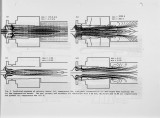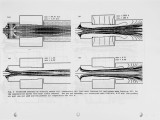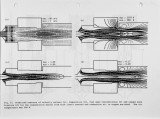| OCR Text |
Show of NO concentration profiles depending critically on the mean concentration of the 0 radicals with allowances made for non-equilibrium val ues and on the temperature. The prompt-NO concentrat ion profi 1 e in turn depends cri t i cally on the mean concentrat i on of CH radi cal s and on the temperature of the fl arne. Therefore the turbul ent model employed in the present model is improved by descri bi ng the react i ng mi xture wi th a two dependent vari ab 1 e system for wh i ch the fi rst moments are obta i ned from sol ut i on of the transport equat ions. The mean turbul ent react ion rate w can be described in terms of the instantaneous rate wand a joint pdf of various variables. w=Jw (V l' V 2' ••• ) P (V!, V 2' ••• ) dV 1 ' dV 2' •••• (7) where VI' V 2' •.•• are temperature and various species concentrations present. In the present study the joint 2-variable pdf is used for weighting against the instantaneous rates of production of NO (eg. equation 1) and subsequent integration over the suitable ranges to obtain the mean turbulent reaction rate. Therefore equation (7) can be shown as: (8) where SNO is the mean turbul ent rate of product i on of NO, SNO is the instantaneous rate of production given by equations 1 and 4 and -P (VI' V2) is the joint pdf of the variables VI and V2• It is further assumed that the variables VI and V2 are statistically independent so that P (VI' V2) can be expressed as: (9) where PI_and P2 _are assumed to be two-moment beta functions of the first moments VI and V2, whic~, is appropriate for combustion calculations (16, 18). The second moment VI2 was assumed to be related to the first by: (10) where sis a coeffi c i ent to be selected to represent the i ntens i ty of fl uctuat ions, and the term in brackets is the top 1 imi t of the second moment. Higher s values correspond to high Damkohler numbers representing wrinkled laminar flame regimes and lower ones to the distributed combustion regimes. In order to limit the computational time, each beta funct i on was evaluated at 10 poi nts on a histogram base. A sens i t i vi ty ana 1 ys is pri or to the deta i 1 ed computat i on was carri ed out for the beta funct ions, so that when VI or V were near thei r extreme val ues, the as soc i ated beta funct i on was rep Taced by a delta funct ion instead; the instantaneous rate of production was directly incorporated to the program. The package is wri tten so that the vari ab 1 es VIand V 2 can be selected depending on the type of NO formation in question. For example, for thermal NO VI.. was temperature and V2 was 0 radical mass fraction and for prompt -NO they were temperature and CH mean mass fract ion 7 |



























